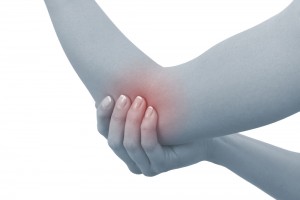
At this time of year many of the elves have been sending greetings to friends and family. One or two particularly industrious elves cut out hundreds of snowflakes from really thick paper to produce a huge pile of handmade cards and are now nursing sore forearms and elbows. Like almost 3% of the population they are suffering from lateral epicondylitis, also known as tennis elbow. This condition causes pain at the outside of the elbow and can be worse on activities involving gripping, or lifting the wrist up.
The affected elves wanted to know the best way to treat this. Eccentric exercise, where the muscle lengthens (rather than shortens) against resistance, has been a popular method of treating this condition for some time, but does current evidence support this? We found this recently published review asking just that question.
Here’s what they did
Six electronic databases (ProQuest, Medline via EBSCO, AMED, Scopus, Web of Science, and CINAHL) were searched for randomised or controlled trials involving participants diagnosed with lateral epicondylitis where at least one treatment intervention involved eccentric exercise and at least one functional or disability outcome measure was used to assess the outcome of treatment. Methodological quality was assessed using the Modified Cochrane Musculoskeletal Injuries score sheet, and studies rated either ‘low’, ‘medium’ or ‘high’ quality.
Here’s what they found
Of 392 articles, 12 (eight RCTs) were included in the review. Two studies were deemed ‘low’ quality, seven ‘medium’ and three ‘high’. The most common methodological weakness was lack of blinding of participants and therapists, but few reported sample size or statistical power. There was wide variation in diagnostic criteria, exercise parameters, and measurement methods and a failure to accurately report exercise protocols. Only four studies documented exercise adherence and just three had follow up beyond 24 weeks. The studies and findings were grouped into four categories:
- Isolated eccentric exercise programme v different therapies (n=1) No greater benefit for pain when compared to a programme of iontophoresis, ultrasound and stretches
- Eccentric exercise and adjunct therapies v the same adjunct therapies (n=4) The addition of eccentric exercise led to a greater reduction in pain, disability, and/or improvement in grip strength in three studies. One study found no difference.
- Eccentric exercise and adjunct therapies v different therapies (n=5) Eccentric exercise when combined with adjunct therapies resulted in significant improvements in pain, function and grip strength.
- Identical eccentric exercise programmes with different study parameters (n=2) mprovements were found in both pain and function in all eccentric exercise programmes
The authors concluded
Eccentric exercise, used in isolation or as an adjunctive therapy, decreases pain and improves function in lateral epicondylitis patients when compared with baseline.
When compared with other treatment therapies, evidence supports the use of multimodal treatment programmes inclusive of eccentric exercise for improving pain and function in lateral epicondylitis patients.

Eccentric exercise, used in isolation or as an adjunctive therapy, decreases pain and improves function in people with lateral epicondylitis.
The Musculoskeletal Elf’s view
 We agree with the authors of this study that standardisation of assessment methods and agreed criteria for the diagnosis of lateral epicondylitis would greatly improve the understanding and management of this condition.
We agree with the authors of this study that standardisation of assessment methods and agreed criteria for the diagnosis of lateral epicondylitis would greatly improve the understanding and management of this condition.
Despite the variation in study parameters, diagnostic criteria and measurement methods the majority of studies reported an improvement in pain and function with eccentric exercise. This means our industrious elves can embark on an eccentric exercise programme knowing that the evidence supports its use – happy days!
We can also look forward to playing tennis in the spring.
What do you think?
- Have you found eccentric exercise to be effective in the management of tennis elbow?
- Have you found compliance with these exercises difficult?
Send us your views on this blog and become part of the ever expanding Musculoskeletal Elf community. Post your comment below, or get in touch via social media (Facebook, Twitter, LinkedIn, Google+).
Links
Cullinane FL, Boocock MG, Trevelyan FC, 2014, “Is eccentric exercise an effective treatment for lateral epicondylitis? A systematic review”, Clinical Rehabilitation, Vol.28, no.1, pp.3-19

Is eccentric exercise an effective treatment for lateral epicondylitis? A systematic review http://t.co/ecCf5XuJwz
Is eccentric #exercise an effective treatment for lateral #epicondylitis? http://t.co/TIXnAgQouk @theCSP @PhysioMACP
#eccentric #exercise for lateral epicondylitis? A systematic review http://t.co/RGGZzhJkvi @TPMpodcast @physio_guru
#tenniselbow is #eccentric #exercise effective? http://t.co/RGGZzhJkvi @TheSportsPT @PhysioTalk @thecspstudent
Do you use #eccentric #exercise for #tenniselbow http://t.co/RGGZzhJkvi @physioNZ @physiosinsport
new blog #tenniselbow #eccentric #exercise does it work? http://t.co/RGGZzhJkvi @CSPLondon @physioReel @apaphysio